![]()
![]()
![]()
Use LEFT and RIGHT arrow keys to navigate between flashcards;
Use UP and DOWN arrow keys to flip the card;
H to show hint;
A reads text to speech;
118 Cards in this Set
- Front
- Back
|
Comprehensive Health assessment |
An in-depth assessment of the whole person including physical mental emotional cultural and spiritual aspects of patience health. |
|
|
Focused assessment |
Involves an examination and an interview regarding a specific body system. Such as examining solely the integumentary system or the respiratory system |
|
|
Initial head to toe shift assessment |
Provides you with a quick overall assessment of the patient's condition to establish a baseline against which you can compare later assessments. Neurological, cardiovascular, respiratory, integumentary, gastrointestinal, genitourinary, muscular, skeletal. Vital Signs, appearance, speech, safety risk factors, tubes and Equipment, Comfort or complains, needs |
|
|
Subjective data |
The info the patient or his family and friends tell you |
|
|
5 techniques to collect objective data |
Inspection, observation, palpation, percussion, auscultation, and olfaction |
|
|
Order of abdominal assessment |
Inspection or observation, auscultation, palpation, percussion, and olfaction |
|
|
Signs vs. symptoms |
Signs of disease are those that can be detected by the nurse, while symptoms of disease are apparent only to the patient so they must be verbally communicated to the nurse |
|
|
Inspection |
Visible observation of anything about the body that you can see with the naked eye or with the assistance of other equipment |
|
|
Otoscope |
Lighted instrument used to inspect the lining of the nose, tympanic membranes and ear canals |
|
|
Ophthalmoscope |
Lighted instrument used to assess or examine the internal structures of the eyes |
|
|
Palpation |
The application of your hands to the external surfaces of the body to detect abnormalities of the skin or tissues line below the skin, that is, to examine by touch or feel |
|
|
Light palpation |
Depresses the tissue between 1 and 2 centimeters |
|
|
Moderate compression palpation |
Depresses the tissue between 2 and 3 cm |
|
|
Deep palpation |
Depresses the tissue between 4 and 5 cm |
|
|
Rebound tenderness |
Reflexive tensing of abdominal muscles or verbalization of increased pain with the release of pressure. Common in appendicitis |
|
|
Percussion |
Striking body parts with the tips of fingers to: Elicit sounds that can help locate and determine the size of structures beneath the surface Tell if structure is hollow or solid Detect areas containing air or fluid |
|
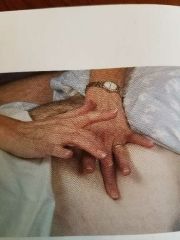
How to do percussion |
Fingers of non-dominant hand placed flat on Surface to be percussed. Use dominant hand, middle fingertips to tap light and quick on the middle finger of non-dominant hand two to three times |
|
|
Blunt percussion |
Use his fists and not finger to tap or percuss, useful in detecting tenderness of the kidneys |
|
|
ASCITES |
Fluid in the peritoneal cavity |
|
|
Fluid wave test |
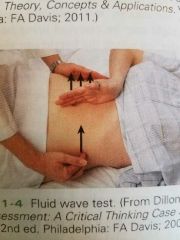
Patient places hand vertically in the middle of abdomen with fingers pointing toward feet. Place hands on each side of abdomen use your fingers to tap on the sides of the abdomen while the other hand palpates the opposite side, tapping will cause a fluid wave felt by the palpating hand if ascites is present |
|
|
Auscultation |
Listening to sounds produced by the body |
|
|
Eructation |
Belching, passing of flatus or rectal gas, loud wheezing or gurgling and Loud bowel sounds |
|
|
Bruit |
Rushing of blood through a vessel such as the Carotid artery |
|
|
Olfaction |
Sense of smell, used to detect odor characteristic of different health problems |
|
|
Halitosis |
Bad breath possibly caused from poor oral hygiene, a sinus infection, or gastric upset |
|
|
Sour smelling breath |
Individuals with high stress levels often have |
|
|
Ammonia or urine smelling breath |
Patients with kidney failure may have this |
|
|
Musty or sweet odor breath |
Patient with liver disease may have |
|
|
Acetone, or fruity smelling breath |
Maybe indicator of diabetes |
|
|
Neurological assessment |
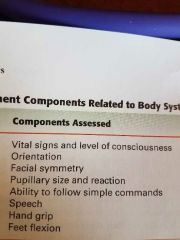
|
|
|
Cardiovascular assessment |

|
|
|
Respiratory assessment |
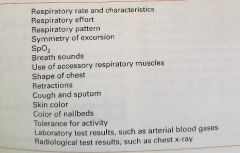
|
|
|
Integumentary assessment |
Skin color, texture, moisture, and temp Turgor Skin Integrity, including pressure points and lesions Surgical incisions |
|
|
Gastrointestinal assessment |
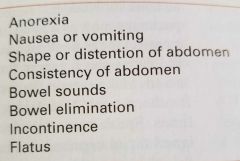
|
|
|
Genitourinary system assessment |

|
|
|
Musculoskeletal system assessment |

|
|
|
Aphasia |
Patient knows what he wants to say but cannot say it |
|
|
Accommodation response |
Pupils constrict when focusing on close objects and dilate when focusing on a fire object |
|
|
Orthopenia |
Difficulty breathing while lying flat |
|
|
Excursion |
Equal chest expansion during inspiration |
|
|
Dysphasia |
Difficulty coordinating and organizing the words correctly |
|
|
ptosis |
Drooping of the eyelid |
|
|
Retractions |
Chest walls appears sunken in between ribs and under the xiphoid process as the patient inhales |
|
|
Sordes |
Dried mucus or food caked on the lips and teeth |
|
|
Rhonchi |
Sort of rattling, however they cleared when patient coughs |
|
|
What part of brain controls the respiratory rate portion of oxygen |
Medulla and pons |
|
|
Part of brain that controls body temperature and autonomic nervous system |
Hypothalamus |
|
|
Part of brain that extends some control over blood pressure and pulse |
The medulla oblongata |
|
|
Skin color |
Pallor indicates poor circulation or anemia while cyanosis indicates hypoxia |
|
|
Lethargy |
Drowsiness or mental sluggishness |
|
|
Four spheres of a patient's orientation level |
Person place time and situation |
|
|
Erythema |
Tissue redness |
|
|
Flexor posturing |
Arms flexed to chest, hands clenched into fists and rotated internally, feet extended, indicates problem is at or above the brain stem |
|
|
Extension posturing |
Arms extended, hands clenched into fists, wrist flexed, and forearm severely pronated or internally rotated, indicates the problem is at the level of the midbrain or pons and is more ominous of the two postures |
|
|
Arcus senilis |
An opaque White Ring around the outer edge of the cornea, common in older adults |
|
|
Anisocoria |
Pupils of different sizes |
|
|
Consensual reflex or consensual response |
Shining Light in either eye should cause both pupils to rapidly constrict simultaneously and equally |
|
|
Candida albicans |
Fungal infection, yeast |
|
|
Painless ulcerations in mouth |
Could be sign of syphilis |
|
|
White lesions and erythema of the tonsils |
Due to infection |
|
|
Severe ulcerations or growths on the oral mucosa |
Maybe cancer |
|
|
An ulceration that has perforated the hard palate or roof of the mouth |
May be indicative of cocaine use |
|
|
Reddish purple or hemorrhagic appearing gums |
Could be sign of leukemia |
|
|
Black hairy appearance of the tongue |
Indicates fungal infection |
|
|
Red beefy looking tongue |
Pernicious anemia |
|
|
Smooth, painful tongue |
Glossitis , due to inflammation or side effect of medication |
|
|
Cheilitis |
Inflammation of the lips, as well as excessive dryness and cracking |
|
|
Cheilosis |
Fissures or cracking at the corners of the mouth, usually related to Vitamin B deficiencies |
|
|
Cherry red lips |
May be a sign of carbon monoxide poisoning and acidosis |
|
|
Pale lips |
Associated with anemia |
|
|
Pale lips where the pallor is circumoral |
Maybe indicative of scarlet fever |
|
|
Endentulous |
Patient without teeth |
|
|
If jugular veins in neck are distended or full enough that you can see them |
Indicative of fluid overload of the cardiovascular system, as in congestive heart failure. |
|
|
Non productive cough |
A dry cough |
|
|
Productive cough |
Cough that produces sputum |
|
|
Rust colored sputum |
Common in pneumonia patients |
|
|
Blood-tinged sputum |
Could be due to tuberculosis |
|
|
Yellow, green, white, clear, frothy, or pink tinged sputum |
Indicative of pulmonary edema as a result of worsening CHF |
|
|
Nocturnal cough |
Coughing that occurs mostly at night, maybe sign of pulmonary edema and CHF |
|
|
Eupnea |
Breathing within normal parameters |
|
|
Atelectasis |
Severe pneumonia or lung collapse |
|
|
Bronchial breath sounds |
Sounds heard over the bronchi, located under the manubrium, shorter inspiration phase longer expiration phase, will sound louder and slightly harsher than other breath sounds |
|
|
Vesicular breath sounds |
Heard over the periphery of the lungs, longer inspiratory phase than expiratory phase, softer rustling sounds |
|
|
Decreased breath sounds |
If there are fewer breath sounds on one side than the other |
|
|
Consolidation |
When secretions and exudate from pneumonia solidify in lung tissues, may result in absence of breath sounds in that lobe |
|
|
Adventitious breath sounds |
Abnormal breath sounds including crackles, rhonchi, wheezes, pleural friction rub, and stridor |
|
|
Crackles or rales |
Discontinuous, usually heard during inspiration, maybe fine or coarse Cannot be cleared by coughing |
|
|
Wheezes |
Continuous melodious musical or whistling sounds of the lungs, caused by constriction of the Airways can be inspiratory or expiratory |
|
|
Pleural friction rub |
Grading, creaking sound due to inflamed edematous pleural surfaces rubbing together during breathing. Sounds often heard during first couple of days of a lung inflammation |
|
|
Pt position for auscultation of breath sounds |
High Fowler's position, if patient can't sit up try to place patient in at least a semi Fowler's position if tolerated. Otherwise Place patient in supine or lateral position for lung auscultation |
|
|
Placement of stethoscope to auscultate breath sounds anteriorly |

|
|
|
Placement of stethoscope to auscultate breath sounds laterally |
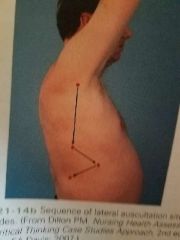
|
|
|
Position of stethoscope to auscultate breath sounds posteriorly |
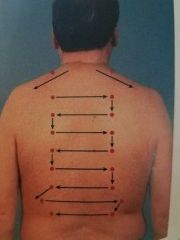
|
|
|
Patient position to auscultate heart sounds |
Sitting, but can also be heard using the left lateral or Supine position |
|
|
Site to best hear the mitral valve, and where you will auscultate the apical pulse for rate Rhythm and strength |
Point of Maximum impulse, because it is located over the Apex of the left ventricle . for most patients, this is the spot just inferior to the left nipple |
|
|
Site to auscultate the aortic valve |
2nd intercostal space, just to the right of the sternum, known as the right base heart sound |
|
|
Sites to auscultate the pulmonic valve |
2nd intercostal space just to the left of the sternum, known as the left base heart sound |
|
|
Site to auscultate the tricuspid valve |
Edge of the sternum at the level of the fourth intercostal space, just left of sternum, also known as left lateral sternal border heart sound LLSB |
|
|
Cardiac auscultation sites |

|
|
|
Heart murmur |
Hear extra heart sounds, may present as a swishing, rumbling, or blowing sound, or maybe soft, loud, or booming |
|
|
Auscultation of abdomen for bowel sounds |
Begin listening in right lower quadrant, then right upper quadrant, then left upper quadrant, and lastly left lower quadrant. Pattern tracks the ascending colon up to transverse colon and then to descending colon and sigmoid |
|
|
Peristalsis |
Wavelike muscular contractions of the intestines that move intestinal contents through the alimentary canal where absorption of nutrients and water takes place, toward the rectum for elimination |
|
|
Bowel sound normal range |
Should be between five and thirty clicks or gurgles per minute in each of the four quadrants, should be high-pitched, known as active bowel sounds |
|
|
Hypoactive bowel sounds |
Fewer than five clicks or gurgles per minute in any quadrant of bowel sounds, result of slowed peristalsis |
|
|
Active bowel sounds |
Between 5 and 30 clicks or gurgles per minute in each of the abdomen 4 quadrants |
|
|
Hyperactive bowel sounds |
More than thirty clicks are gurgles per minute in four quadrants of abdomen |
|
|
Borborygmus |
Gargling bowel sounds that are loud enough to hear without stethoscope |
|
|
Guarding |
Defense mechanism of tightening the abdominal muscles to prevent further compression of tender or inflamed areas |
|
|
Paresthesia |
Numbness or decreased sensation in skin, commonly seen as a complication of diabetes and a result of stroke |
|
|
Solar lentigines |
Numerous spots of yellowish Brown discoloration of skin caused by years of sun exposure, common in elderly patients |
|
|
Diaphoretic |
If patient is perspiring she is considered diaphoretic |
|
|
Pale, skin color descriptor |
Lighter color, more white than usual. If not the patient's normal Fair coloring, indicates poor circulation, anemia |
|
|
Erythematous, skin color descriptor |
Redness of designated site. Usually sign of inflammation due to increased circulation to inflamed site |
|
|
Flushed, skin color descriptor |
Widespread, diffuse red color of face, possibly includes the body. Usually caused by fever, embarrassment, exertion, sunburn. |
|
|
Jaundiced, skin color descriptor |
Yellow or orange coloring of skin and mucous membranes, Easily detected in the sclera and palm of hands. Jaundice caused by liver impairment. |
|
|
Cyanotic, skin color descriptor |
Bluish gray color of skin and mucous membranes. Do to hypoxia and extreme vasoconstriction |
|
|
Ecchymotic, skin color descriptor |
Caused by bruising of skin. Fresh bruises are bluish purple, older bruises turn yellow green as they begin to resolve |
|
|
Bronzing, skin color descriptor |
Bronze pigmentation of skin, due to disorders of iron metabolism. Iron pigments are deposited in body tissues |

